
Natural Gardening
There are many ways to grow tomatoes. Staking them or putting a wire cage around them or easier easy ways like letting them grow wild or stringing them up. I like all ways, but I have worked out a little twist on letting them grow wild.

If you plant tomatoes and let them grow wild, they will soon take up all the space in your garden and they will have formed so many laterals, you won’t know where the plant starts and ends.
The fruit will be lying on the ground and getting attacked by every pest known to man. What you thought would be the easy way has turned into the hard and non-productive way. You mutter to yourself as you pull that bloody tomato vine out. But you get a few shining moments as you rescue a few beautiful vine ripened tomatoes.
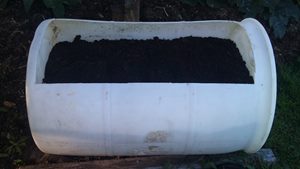
Instead of growing your tomatoes in the garden, grow them in a 200litre plastic drum.
Get some really good soil and add some worm castings, maybe some rock dust and some compost.
I learnt to grow tomatoes the easy way by accident. I had a 200 litre drum, on its side, as a worm farm. When I made my bigger worm farm, the drum was left sitting for a while and a volunteer tomato and passionfruit grew out of the worm castings. I didn’t take much notice and then some fruit formed so I kept and eye on it. The tomato produce quite a few fruit, had no disease and very few pest problems. I credited its good performance to the worm castings.
Because tomatoes are such hardy beasts, I didn’t shower it with much attention and only watered it if it wilted. Sometimes that would be a month to six weeks after a downpour of rain. If tomatoes were getting close to the ground, I raised them up by putting a block of wood under them.
Because the tomato had to grow up and out of the drum, I only had to support one tenacious lateral with tomatoes on it.
Getting Ready To Transplant Seedlings

These are Black Russian tomato seedlings. On the left are the remaining two from a punnet bought at Bunnings. Your can see they have been neglected in comparison to the two from the same punnet, planted in the wicking bed. In the punnet is a seedling I grew from seed. The seed was purchased from The Seed Collection. It was looked after a bit better than the others.


When I plant tomato seedlings, I plant them so that the leaves are right at soil level. This allows more roots to grow from the stem.
After planting I water them very well and won’t water again for at least 4 weeks, or if they are wilting in the morning before it has warmed up. They are hardy beasts and by not watering, they don’t grow all long and leggy. The idea is to make them want to produce fruit and you don’t want them to grow a lot between each level of fruit.
If a plant thinks that it might not survive, it produces fruit to ensure the species ongoing survival. Treat it too well and it doesn’t use it resources to maximise fruit production. Like us, when we get too comfortable, we don’t try to improve our situation.

Alternative Thinking, Rants
Does the price of clothes washing detergent give you the “tom tits”? Do you get annoyed when it is time to buy more laundry detergent and you don’t get any change from $20 for a 4 litre liquid detergent? I do and I get sick of the bs advertising where they give the detergent an earth friendly name to fool the consumer that the manufacturer is environmentally sensitive.
I’m going to make my own home made laundry detergent.

Receipt for 3 of the 4 items
Plan
- Find a recipe for laundry detergent
- Buy the ingredients
- Make the detergent
- Use it
- Write a blog post about it
The fourth item is Borax which costs about $4 from Coles. My total expenditure is $12.29
Recipe for home made laundry detergent

Ingredients: 1 bar of soap, grated; 1 cup Lectric washing soda; 1/2 cup borax; some Bi-carb soda

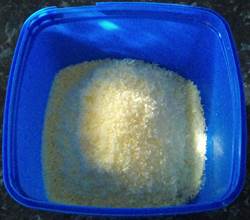
Grate the soap. I used the fine tooth on the grater and the soap ended up looking like Parmesan cheese. It surprised me as it had quite a pleasant fragrance.
Add the cup of washing soda and 1/2 cup of borax


 If you want to make the mix stronger, add a small box of bicarb-soda to the mix. I wasn’t sure what a small box measured so added about 1/2 a cup.
If you want to make the mix stronger, add a small box of bicarb-soda to the mix. I wasn’t sure what a small box measured so added about 1/2 a cup.
Mix together and store in a sealed container. I used the trusty old 2 litre ice cream container. I’m running out of them so will have to hook in to some more ice cream.
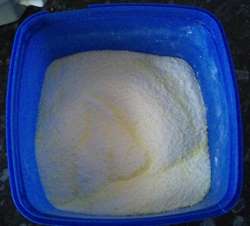
The finished product
There is about a kilo of finished product in the container.
Amount to use
3 small teaspoons per wash
The recipe for this home made laundry detergent came from Warm Earth magazine. The writer said it was a tried and tested recipe from their place.
We used the recipe as soon as it was made. I thought it was great in the washing. Now ladies, just don’t think this is some dopey old bloke’s opinion. My lady friend was kind enough to do the washing and her opinion was she couldn’t tell the difference from the previous load using a commercial washing liquid. Rest my case.
I hope you have a go at making this laundry detergent. I have enough ingredients left over to make another 3 batches.
If enough people start looking for alternatives to commercial products, then maybe manufacturer’s will wake up and realize that they have to provide value for money and stop looking for ways to provide the cheapest cost item for the greatest price backed by marketing and advertising to brainwash the consumer.
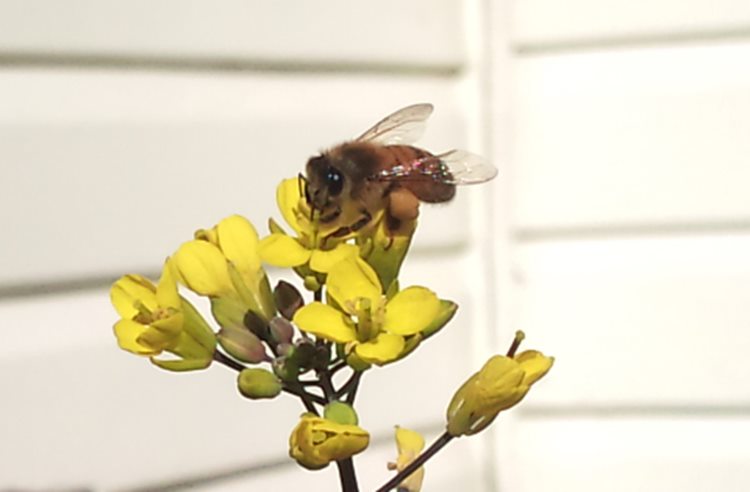
Natural Gardening
 Have you noticed in your garden that there are relationships between different life forms where one form of life is dependent on another life form for its survival. The easiest symbiotic relationship to see is a flower and a bee. The flower produces pollen, which is one half of its survival mechanism. In order to reproduce, the flower needs this pollen to be distributed.
Have you noticed in your garden that there are relationships between different life forms where one form of life is dependent on another life form for its survival. The easiest symbiotic relationship to see is a flower and a bee. The flower produces pollen, which is one half of its survival mechanism. In order to reproduce, the flower needs this pollen to be distributed.
Pollination definition from Wikipedia.
Pollination is the process by which pollen is transferred from the anther (male part) to the stigma (female part) of the plant, thereby enabling fertilization and reproduction. It is is unique to the angiosperms, the flower-bearing plants.
Enter the bee
The bee is attracted to the pollen produced by the flower and happily skips from flower to flower collecting pollen, it also fertilises the flower so that it can create seeds and ensure its future survival. Without the bee the flower would be relying on other less productive insects for its pollination.
The ginger family and earthworms
If you have ever harvested ginger, galangal, turmeric, kraichi or any other ginger like rhizomes you will dig up a lot of worms that have made home in the rhizomes. They are not your small red wriggler compost worms but the large fat deep diving ones that are usually found deeper in the garden. Yet here they are only a few centimetres deep in the rhizomes.
Maybe, like in Dune (a science fiction classic) the ginger family has a thumper that creates a pulse or rhythmic beat that attracts these worms to the rhizome. Or, more likely, the rhizome exudes a substance that is intoxicating to the worm and attracts them. In return the plant benefits from the worm castings.
 I harvested some turmeric yesterday but didn’t take a snap of the worms. But I watched a RobBob video of him harvesting some garlic and turmeric and the worms he found in the rhizomes. Click on the video and it will open in a new window
I harvested some turmeric yesterday but didn’t take a snap of the worms. But I watched a RobBob video of him harvesting some garlic and turmeric and the worms he found in the rhizomes. Click on the video and it will open in a new window
Soybeans and Rhizobia bacteria
An invasion of soybean aphids poses a problem for soybean farmers requiring application of pesticides, but a team of Penn State entomologists thinks a careful choice of nitrogen-fixing bacteria may provide protection against the sucking insects.
Soybeans are legumes, plants that can have a symbiotic relationship with nitrogen-fixing bacteria — rhizobia — and therefore do not need additional nitrogen fertilizer. Each type of legume — peas, beans, lentils, alfalfa — have their own rhizobia.
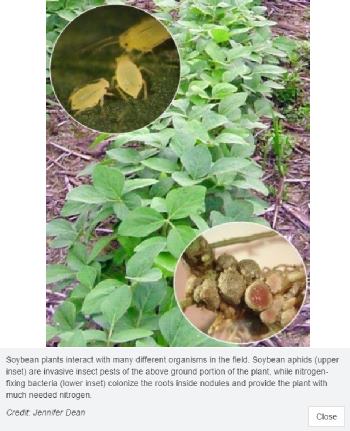 “Soybeans are from Asia and so there were originally no nitrogen-fixing bacteria that would colonize soybeans in U.S. soils,” said Consuelo De Moraes, associate professor of entomology. “The rhizobia had to be transferred here.”
“Soybeans are from Asia and so there were originally no nitrogen-fixing bacteria that would colonize soybeans in U.S. soils,” said Consuelo De Moraes, associate professor of entomology. “The rhizobia had to be transferred here.”
The soybean aphid is also not native to North America. This pest only began to infest soybean fields about 10 years ago but are now fully established pests requiring pesticide applications to avoid the loss of as much as 40 percent of the crop. The researchers investigated the relationship between the type of rhizobia colonizing soybean plants and the plants’ infestation with the aphids.
“Our results demonstrate that plant–rhizobia interactions influence plant resistance to insect herbivores and that some rhizobia strains confer greater resistance to their mutualist partners than do others,” the researchers report in the journal Plant and Soil online.
The above information is from Science Daily. The complete article goes on to describe how wild native rhizobia bacteria help overcome the problem of the soybean aphid, but the bacteria used as an innoculant is an aggressive bacteria that fights off the wild native bacteria. They describe the experiments undertaken to prove their theory.
Fortunately, here in Brisbane I haven’t had the problem of aphids in the soybeans I grow, needless to say, one day it will come. At the moment I grown soybeans all year round. That way I am trying to create a wild bacteria that is in the ground and becoming indigenous. I harvest some seed early and let it fall into the garden. By the time I harvest the rest, young soybean plants are growing and providing a home for the rhizobia bacteria in the nodules they create in the root system.
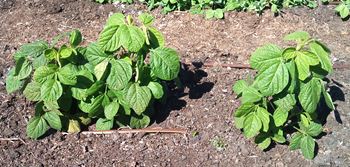 This picture was taken this morning. It is late winter here in Brisbane and although these are not growing as well as in summer, they are providing a home for the rhizobia. This is the first time I have done this and it will be interesting to see the result and if they produce any beans. There are a couple of other soybean posts that should be listed in the tags below.
This picture was taken this morning. It is late winter here in Brisbane and although these are not growing as well as in summer, they are providing a home for the rhizobia. This is the first time I have done this and it will be interesting to see the result and if they produce any beans. There are a couple of other soybean posts that should be listed in the tags below.
All the above examples are symbiotic relationships where both parties get benefits from their relationship. The bee gets pollen and the flower is pollinated. The worm, I am sure gets something and the ginger gets the benefit of tunnels for oxygen and the goodness from the worm castings. The soybean gets the nitrogen from the rhizobia in a form that it can uptake and the bacteria gets a root exudate that it can feed on.
Pathological dislike
From working in the garden and seeing all these things going on, I sometimes wonder why I have a pathological dislike for cabbage moths and cane toads. I am sure that there is something that benefits from their existence, but as yet I am still unable to fathom it.
What about ourselves? How do we benefit this earth that we live on? If you watch the television or read a newspaper there is not much evidence that we are a benefit. It would appear that man and woman are more a detriment than a benefit.
Fortunately there are quite a few people out there who are trying in their own way to lessen their detrimental footprint and improve their beneficial one. People like RobBob and many others whose blogs I have read or YouTube channels I have watched.
I read one blog where the young lady from Melbourne has gone plastic free. I haven’t got that enthusiastic yet, but every time I find plastic in my compost, I think of her and send up a silent thank you for people like her.
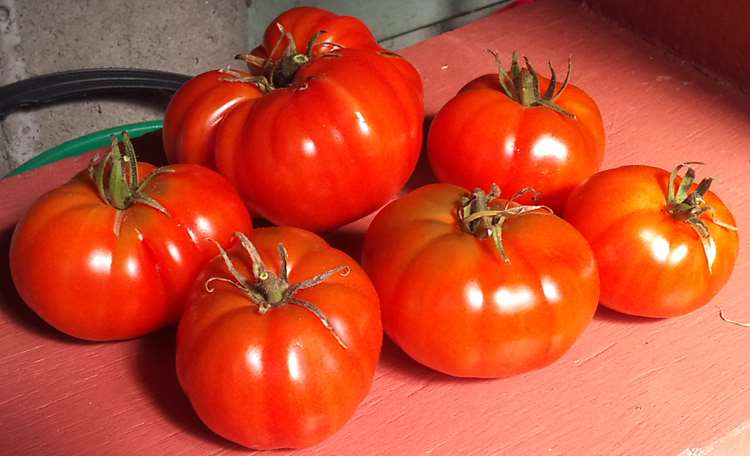
Uncategorized

Nothing beats fresh picked tomatoes
Tomatoes would have to be close to the favourite fruit I like to grow. Nothing beats looking after a tomato bush and looking forward to picking them. The distinctive aroma that is transferred to your hands when you touch them to tie them up can’t be beaten, imho.
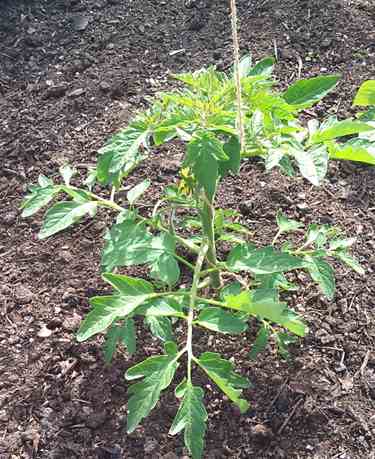
Tying up a young tomato plant
The best way I have found to grow tomatoes is to grow them in an environment that restricts insect attack and to tie them up on a string.
This young Black Russian tomato plant is being grown in the wicking bed and is protected from insect damage by a frame covered in fruit fly mesh. Notice the string winding around the stem of the plant. As the plant grows you wind it around the string to support the plant.

Turnbuckle to keep wire taut
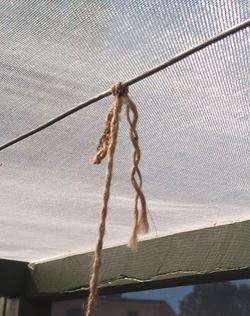
Once your supporting wire is in place, a simple slip knot is used to attach the string.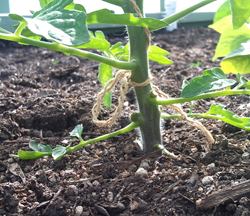

Wind the string down around the plant to the base. Make a loop and pull it back behind the string and the pressure from the wind will hold it in place. As the plant grows all you need to do is wind the tomato around the string.
There are a couple of tricks to look out for. The first one is if you have a number of tomatoe plants it helps to wind them the same way. It will depend on if you are left or right orientated whether you wind them clockwise or anti. Try one way and if it feels funny or awkward try winding the other way.
Tomatoes are bullet proof.
If you can grow your tomatoes in a protected environment your will find that tying up tomatoes makes them a gardener’s best friend. They are practically bullet proof. Even if you break them they will surprise you by growing another leader that produces tomatoes.
Recap
- Get your support wire in place
- Plant your tomato seedlings
- Drop your supporting strings from the wire
- About four weeks after planting seedlings it is time to tie them up
- Wind the tomatoes and prune on a weekly basis depending on weather conditions (longer in winter)
Now that your tomatoes are tied up, the next information needed is pruning and winding. Probably next week.























